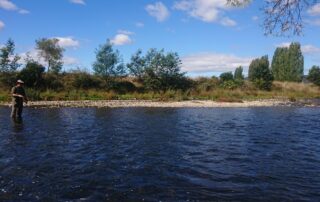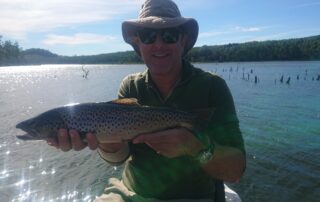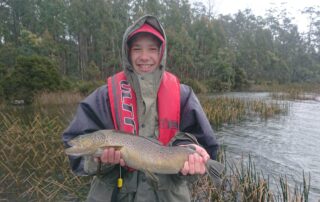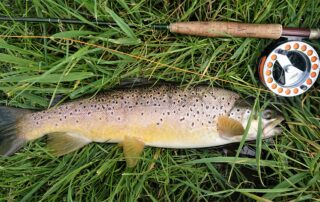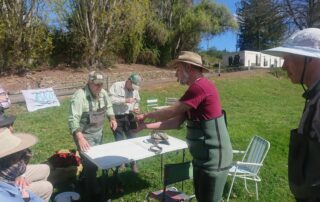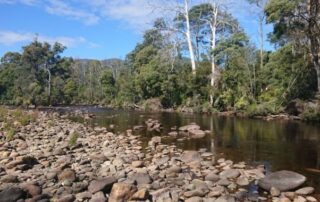Lurking in a little creek
It was late April, and armed with a 3 weight rod and a grasshopper I set off for an afternoon fish on a stream no wider than a kitchen table. This small creek winds its way through the northern midlands. Once upon a time it was known as Penny Royal Creek. Occasionally we do come across some surprisingly good specimens. This fish was caught again and released by another angler a week later.
Another day in April
Another day in early April, on the Mersey River. In the absence of any surface activity Mark worked a tungsten bead nymph under a dry fly to secure a chunky rainbow and a couple of small browns. This is a wide open riffle section of the river, not too difficult to wade, and with plenty of room for casting, even for up to two people.
Smelt Feeder
On this particular day earlier in April, it was hard to find enough mayfly on the surface or find any fish even looking for them. The tactic here was to find bust ups of small smelt spraying on the surface and the signs of charging trout. We hang in on the zone until they show again, then cast. Mark is pretty happy with this wild brown trout.
Early spring on Four Springs
In September Joe, Kayla, and MJ rugged up warm for a fun day learning to fly fish on Four Springs. The first mayflies had not started to appear yet, as the water temperature was not warm enough. So we used wet flies, imitating fish and subaquatic organisms, learning how they move. This fish responded to a rather slow retrieve, and MJ got to feel the weight, and practice controlling a good fish with the fly rod from the boat, close to the bank and other aquatic structure. MJ steering the fish to the boat, Kayla netting it. MJ with [...]
Floodwaters brownie
Late October with the Macquarie in prolonged flood through a back to back annual La Nina weather pattern, the Macquarie browns are putting on great condition with the amount of available foods, and given the right conditions, this beautiful brown trout was feeding on adult mayflies and damselflies. Talking about the right conditions... what are they? In this case, it was light winds, overcast skies, the temperature around 20 deg Celsius. Limited window, this was through the middle hours of the day. Talking about available foods... why is that? With prolonged raised water levels, grubs, spiders, worms, beetles, etc. forced [...]
Waterbug Blitz
Larva is the stage of development of an insect between egg and pupa. Instar is a stage of life of an insect between two periods of moulting. Nymph is an immature form of an insect. The shedding phases. Pupa is an insect in the stage of development between larva and imago (aka: Emerger - a word commonly used in fly fishing terms when talking about mayfly emergence). It's more involved than that, of course, but there's a quick little summary. Why are we talking about this? Because we participated in a project and were excited to find some up close. [...]
River Leven Tasmania
River Leven TasmaniaThe River Leven is a wild trout fishery in Tasmania's north west. A bubbly, boisterous river, it is long, with much of it in deep forest and gorge terrain. A river of classic runs, riffles, glides, and pools etc. The head waters start not far from Cradle Mountain and enters the sea at Ulverstone.Great trout fishing can be found on the River Leven late season, boasting beautiful coloured wild browns a month or so away from spawning. Cool water temperatures, clean tannin water, and the fish still willing to take dry flies.It's a diverse fishery, and this is [...]
South Esk River Tasmania
SOUTH ESK RIVER The South Esk River is Tasmania's longest river, rising to the east of Ben Lomond and flowing east then south to Fingal where it then turns to the south west and follows the Esk Main Road toward Conara, then turns North West where the Macquarie River flows into it at Longford, flowing on through Hadspen to the Trevallyn Dam in Launceston, the final leg courses through the Cataract Gorge into the Tamar River estuary. We love the South Esk, there are so many great access points to generally clear water, many tributaries joining it along the [...]
Nineteen Lagoons Tasmania
NINETEEN LAGOONS - Gateway to the Western Lakes Wilderness Consisting of a network of lagoons, each with its own individual characteristics, some isolated, others connected via creek systems, these waters are within an easy reach of the highland accommodation base at Miena in the Central Highlands and are a fly fishing paradise. The lagoons surround Lake Augusta and provide a taste for the more remote section of Tasmania's enchanting fishery. A gateway to the Western Lakes, the lagoons have a varied food supply, due to their individual geography; some are rocky, some are shallow, some deep, others with sandy bottoms, [...]
Meander River Tasmania
MEANDER RIVER The Meander River, in northern Tasmania, is approximately 45 minutes drive from Launceston. A clear, boulder strewn fast water, the Meander is a tail race water from the Huntsman Dam, which has a good regulated environmental flow. It's a clear, fast water, with some deep holes and slow sections, with both brown and rainbow trout. ANGLERS ACCESS The Inland Fisheries Service also provides useful information about many Tasmanian trout waters, including access points, anglers notes, and maps. Brochures are available at most fishing stores, visitor centres, or online. See the Anglers Access for Meander River. See here for full [...]


